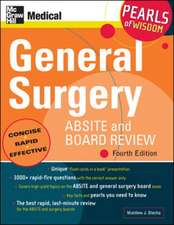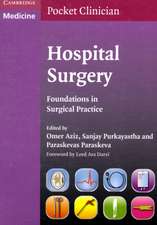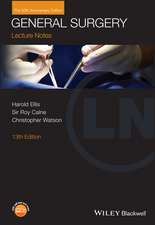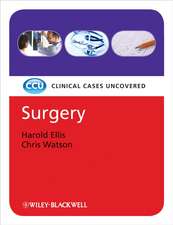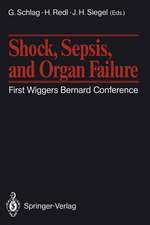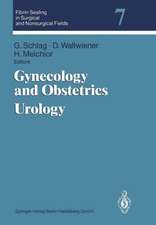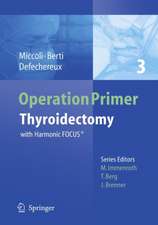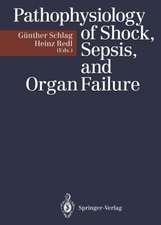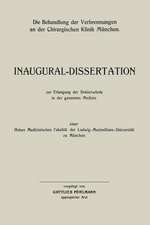Fibrin Sealing in Surgical and Nonsurgical Fields: Volume 1: Wound Healing
Editat de Günther Schlag, Heinz Redlen Limba Engleză Paperback – 17 feb 1994
Preț: 709.87 lei
Preț vechi: 747.23 lei
-5% Nou
Puncte Express: 1065
Preț estimativ în valută:
135.83€ • 141.82$ • 112.42£
135.83€ • 141.82$ • 112.42£
Carte tipărită la comandă
Livrare economică 04-18 aprilie
Preluare comenzi: 021 569.72.76
Specificații
ISBN-13: 9783540575115
ISBN-10: 3540575111
Pagini: 164
Ilustrații: XII, 149 p.
Dimensiuni: 170 x 242 x 9 mm
Greutate: 0.27 kg
Editura: Springer Berlin, Heidelberg
Colecția Springer
Locul publicării:Berlin, Heidelberg, Germany
ISBN-10: 3540575111
Pagini: 164
Ilustrații: XII, 149 p.
Dimensiuni: 170 x 242 x 9 mm
Greutate: 0.27 kg
Editura: Springer Berlin, Heidelberg
Colecția Springer
Locul publicării:Berlin, Heidelberg, Germany
Public țintă
ResearchDescriere
These eight volumes, which developed out of the international con gress "Update and Future Trends in Fibrin Sealing in Surgical and Nonsurgical Fields" held in November 1992, attempt to present the state of the art concerning fibrin sealing. Initially fibrin sealant played an important role in surgery. During the past few years, however, it has been increasingly used in nonsurgical applications, and we can now say that it has become a component of medicine in general. The doubts about the efficacy of fibrin sealant, which had been raised by nonusers, are no longer valid. The correct indication and method ology continue to be basic prerequisites, and even today - after 20 years of fibrin sealant renaissance - the three most prominent effects of fibrin sealant still retain their validity: hemostasis, sealing and sup port of wound healing. The problems posed by the transmission of viral infections have gained substantially in importance because of the potential transmission of AIDS via fibrin sealant. Fortunately the transmission of AIDS via fi brin sealant is today so unlikely that it no longer poses a cause for con cern. This does not mean, however, that research in this field can be discontinued.
Cuprins
I. Biology of Wound Healing.- The Cellular Biology of Wound Healing.- Does Fibrin Play an Important Role in Wound Healing?.- II. Biology Regarding Fibrin Sealant.- Hemostasis — An Important Aspect of the Efficacy of Fibrin Sealant: Experimental Models Designed to Demonstrate the Hemostatic Effect of Fibrin Sealant.- An Evaluation of the Use of Aprotinin (Antifibrinolytic Drug) for Fibrin Sealing in General and Thoracic Surgery.- Comparative Studies on the Physicochemical Properties of Tisseel and a Newly Developed Fibrin Sealant.- Fibrin Glue in Skin Healing: An In Vitro Study.- Wound Healing and Fibrin Glue : An Experimental Comparative Study.- In Vivo Studies of Fibrin Sealant Ultrastructure.- Immunohistochemical Distribution of Collagen Types IV, V, and VII During Wound Healing of Rat Skin After the Application of Tissucol.- Influence of Fibrin Sealant and Fibrin Sealant-Antibiotic Combination on the Healing of Colonic Anastomosis in the Rat.- Fibrin Sealant in Bone Regeneration.- Histological Investigation of Bone Healing in the Rat Calvaria After the Use of Fibrin Glue.- III. Biomaterials and Other Substances in Connection with Fibrin Sealant.- Calcium Phosphate Ceramics (Triosite) in Otology: Evaluation in Animals and Application in Humans.- The Osteoinductive Potential of Bone Morphogenetic Gelatin Complexed with Hydroxyapatite and Fibrin Glue.- Hyaluronic Acid Modifies and Reduces the Inflammatory Response Seen After Trauma and Treatment with Fibrin Glue.- Fibrin Glue as a Vehicle for the Application of Hyaluronic Acid.

